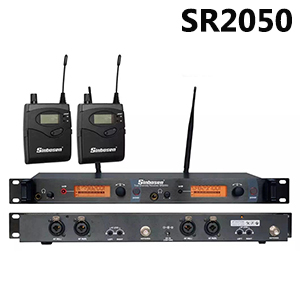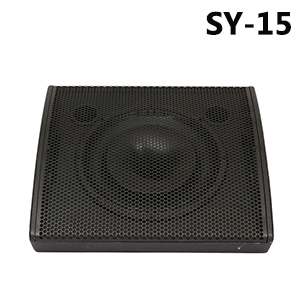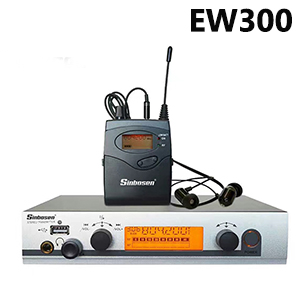Знаете ли вы, каковы обычные системы мониторинга сцены?
: 14452
: 2022-03-21 18:46:46
Sound reinforcement, it mainly includes live sound reinforcement (FOH or PA) and stage monitor sound reinforcement (MONITOR), and there is a close connection between the two. The stage monitoring system is a sound reinforcement system provided for performers on the stage, and it is the direct guarantee for the performers to perform successfully. The quality of the performance plays a very important role. So what are the common stage monitoring systems?
1.Shared monitoring system
The shared monitoring system is the earliest and most widely used stage monitoring system. In the performance, the speakers are usually placed evenly along the front of the stage facing the stage, or directly in front of the monitored object to provide a unified audio signal for the performance area, mainly to make the return sound evenly distributed in the performance area of the stage, such as As shown in the figure, it is also called loudspeaker return. The speaker system is generally horizontal, which does not affect the beauty of the stage and provides a good listening experience.
Due to the performance needs, the performers sometimes need to walk on the stage during the performance. Because the return speakers have a certain directivity, there will be listening blind spots, and the sounds heard by the performers sometimes appear as "sound shadow areas". In the case that the stage is deep and wide, or the monitor cannot be placed on the stage due to some other objective reasons, the setting of the monitor system will be very limited. At this time, some speakers are often placed on the side of the stage and pointed into the stage. The recoil speakers installed on both sides of the stage are often called "Side-Fill". Setting up Side-Fill speakers can reduce the dead zone of listening when the singer moves left and right, so that the performers on the stage can hear a fuller and more impactful sound, and the return sound effect will be more satisfactory. The biggest advantage of using a shared monitoring system is that it is simple and practical. The actors on the stage share the monitoring signal through the speakers, which also reduces the work of separate control for the tuner. While saving costs, the system can solve the listening problem of most people, so the shared monitoring system is almost an indispensable form of return signal playback in the sound reinforcement system.

2.Wireless personal monitoring system
The wireless personal monitoring system (IEM System) can convert the audio signal into wireless signal transmission, and finally transmit the sound signal to the special audience through the in-ear headphones, so that the user can obtain a clearer listening experience. It is a type of stage monitoring system suitable for medium and large performances. A wireless personal monitoring system is similar to a wireless microphone system and consists of a signal transmitter, receiver and earphones. Performers who play back the same signal can share a signal transmitter through a fixed frequency. Because the system terminal uses the earphone to play back the monitoring signal, it is also called the earphone monitoring system. The whole monitoring system is light in weight and small in size, and can be worn on the user like a wireless chest microphone.

The biggest advantage of using wireless ear monitoring is that the performer only needs to wear the receiver on his waist or put it in his pocket, and he can walk around and perform freely within the range allowed by the signal reception. However, it should be noted that since the sound signal is transmitted wirelessly, interference between the wireless monitoring system and the wireless microphone is easy to occur. Therefore, the stability of the radio frequency is the biggest factor affecting the wireless personal monitoring. When using, pay attention to the radio frequency distribution of the two sets of wireless systems, and the two should be kept away from each other as much as possible.
For singers, they often cannot hear their own voice when singing live, so the singer needs to listen back to monitor whether his voice is out of tune. The singer can't hear the accompaniment or the accompaniment is delayed, and the ear return also sends the accompaniment to the singer's ear. The live venue is not a small room, so there will be delays in the sound (that is, the singer often hears the accompaniment too late) or deteriorated, so the ear return sends the accompaniment to the singer's ear to ensure that they will not sing the wrong beat or out of tune. The host will also use the ear back. For the host, the choreographer can use the ear back to guide him to arrange the program, such as inserting commercials, guests entering the venue, correcting slips of the tongue, etc.
Wireless personal monitoring system - Generally, you can choose to monitor mono or stereo mode according to your needs. A comparison of wireless personal monitoring and shared monitoring systems is shown in the table below.

3.Wired band monitoring system.
With the popularity of large-scale music programs, the live accompaniment of the band has become the highlight of the program. The performance and listening habits of the musicians are different, and almost everyone has different monitoring needs. The complexity of the monitoring system can be imagined, which also poses new challenges for the live monitoring system. This is the time when wired band monitoring systems come to the fore. The audio signal is transmitted to the band monitoring system around the musician in the form of wired network transmission. The musician receives the audio signal of the return system through the headphones, and can also independently adjust the group settings, routing assignment, volume control, tone modification, etc. Until it conforms to the performance status, it can realize the personalized operation in the true sense and avoid the problem of radio frequency crosstalk in the wireless system. Some band monitoring systems also have built-in ambient sound pickup microphones, which can capture the cheers of the live audience during performances and enhance the sense of presence.
4.Comprehensive application of three types of monitoring systems
At present, the shared monitoring system with loudspeaker playback is still used in the performance site of some comprehensive programs, because the comprehensive performance will also involve dance, chorus and language programs. For medium and large-scale performances, the wireless personal monitoring system serves important actors such as singers and musicians; the shared monitoring system provides a unified monitoring signal for the stage. In large-scale performances with complex and high-quality audio systems, a common monitoring system, a personal monitoring system and a band monitoring system are generally required to exist at the same time. Singers wear wireless personal monitoring systems to walk around the stage and interact freely with the audience; wired band monitoring systems provide accompaniment musicians with return signals to solve the individual problems of musicians' listening; The shared monitoring system can provide audio signals for dance assistants or even the entire stage, and can also make up for the lack of shocking power of headphones; the three are organically coordinated to jointly realize the playback of stage monitoring signals.

Contact Us:
 sales2@sinbosen.com
sales2@sinbosen.com
Whatsapp:https://api.whatsapp.com/send?l=en&phone=8616676738225

1.Shared monitoring system
The shared monitoring system is the earliest and most widely used stage monitoring system. In the performance, the speakers are usually placed evenly along the front of the stage facing the stage, or directly in front of the monitored object to provide a unified audio signal for the performance area, mainly to make the return sound evenly distributed in the performance area of the stage, such as As shown in the figure, it is also called loudspeaker return. The speaker system is generally horizontal, which does not affect the beauty of the stage and provides a good listening experience.
Due to the performance needs, the performers sometimes need to walk on the stage during the performance. Because the return speakers have a certain directivity, there will be listening blind spots, and the sounds heard by the performers sometimes appear as "sound shadow areas". In the case that the stage is deep and wide, or the monitor cannot be placed on the stage due to some other objective reasons, the setting of the monitor system will be very limited. At this time, some speakers are often placed on the side of the stage and pointed into the stage. The recoil speakers installed on both sides of the stage are often called "Side-Fill". Setting up Side-Fill speakers can reduce the dead zone of listening when the singer moves left and right, so that the performers on the stage can hear a fuller and more impactful sound, and the return sound effect will be more satisfactory. The biggest advantage of using a shared monitoring system is that it is simple and practical. The actors on the stage share the monitoring signal through the speakers, which also reduces the work of separate control for the tuner. While saving costs, the system can solve the listening problem of most people, so the shared monitoring system is almost an indispensable form of return signal playback in the sound reinforcement system.

2.Wireless personal monitoring system
The wireless personal monitoring system (IEM System) can convert the audio signal into wireless signal transmission, and finally transmit the sound signal to the special audience through the in-ear headphones, so that the user can obtain a clearer listening experience. It is a type of stage monitoring system suitable for medium and large performances. A wireless personal monitoring system is similar to a wireless microphone system and consists of a signal transmitter, receiver and earphones. Performers who play back the same signal can share a signal transmitter through a fixed frequency. Because the system terminal uses the earphone to play back the monitoring signal, it is also called the earphone monitoring system. The whole monitoring system is light in weight and small in size, and can be worn on the user like a wireless chest microphone.

The biggest advantage of using wireless ear monitoring is that the performer only needs to wear the receiver on his waist or put it in his pocket, and he can walk around and perform freely within the range allowed by the signal reception. However, it should be noted that since the sound signal is transmitted wirelessly, interference between the wireless monitoring system and the wireless microphone is easy to occur. Therefore, the stability of the radio frequency is the biggest factor affecting the wireless personal monitoring. When using, pay attention to the radio frequency distribution of the two sets of wireless systems, and the two should be kept away from each other as much as possible.
For singers, they often cannot hear their own voice when singing live, so the singer needs to listen back to monitor whether his voice is out of tune. The singer can't hear the accompaniment or the accompaniment is delayed, and the ear return also sends the accompaniment to the singer's ear. The live venue is not a small room, so there will be delays in the sound (that is, the singer often hears the accompaniment too late) or deteriorated, so the ear return sends the accompaniment to the singer's ear to ensure that they will not sing the wrong beat or out of tune. The host will also use the ear back. For the host, the choreographer can use the ear back to guide him to arrange the program, such as inserting commercials, guests entering the venue, correcting slips of the tongue, etc.
Wireless personal monitoring system - Generally, you can choose to monitor mono or stereo mode according to your needs. A comparison of wireless personal monitoring and shared monitoring systems is shown in the table below.
| wireless personal monitoring system | Shared monitoring system | |
| Sense of hearing | High-fidelity sound quality, anti-interference | The noise is relatively large. When the space is too large, it is easy to generate echoes, but it can generate loud pressure and a strong sense of impact. |
| Mobility | In the radio frequency reception space, without any restrictions | Once confirmed, it is not easy to make any adjustments |
| Portability | Small size and easy to carry | Large volume and heavy weight, special handling is required |
| Acoustic feedback | Acoustic feedback phenomenon can be largely avoided | It is one of the important factors for the sound feedback of the stage monitoring system. |

3.Wired band monitoring system.
With the popularity of large-scale music programs, the live accompaniment of the band has become the highlight of the program. The performance and listening habits of the musicians are different, and almost everyone has different monitoring needs. The complexity of the monitoring system can be imagined, which also poses new challenges for the live monitoring system. This is the time when wired band monitoring systems come to the fore. The audio signal is transmitted to the band monitoring system around the musician in the form of wired network transmission. The musician receives the audio signal of the return system through the headphones, and can also independently adjust the group settings, routing assignment, volume control, tone modification, etc. Until it conforms to the performance status, it can realize the personalized operation in the true sense and avoid the problem of radio frequency crosstalk in the wireless system. Some band monitoring systems also have built-in ambient sound pickup microphones, which can capture the cheers of the live audience during performances and enhance the sense of presence.
4.Comprehensive application of three types of monitoring systems
At present, the shared monitoring system with loudspeaker playback is still used in the performance site of some comprehensive programs, because the comprehensive performance will also involve dance, chorus and language programs. For medium and large-scale performances, the wireless personal monitoring system serves important actors such as singers and musicians; the shared monitoring system provides a unified monitoring signal for the stage. In large-scale performances with complex and high-quality audio systems, a common monitoring system, a personal monitoring system and a band monitoring system are generally required to exist at the same time. Singers wear wireless personal monitoring systems to walk around the stage and interact freely with the audience; wired band monitoring systems provide accompaniment musicians with return signals to solve the individual problems of musicians' listening; The shared monitoring system can provide audio signals for dance assistants or even the entire stage, and can also make up for the lack of shocking power of headphones; the three are organically coordinated to jointly realize the playback of stage monitoring signals.

 |
 |
 |
 |
 |
 |
Contact Us:
Whatsapp:https://api.whatsapp.com/send?l=en&phone=8616676738225







